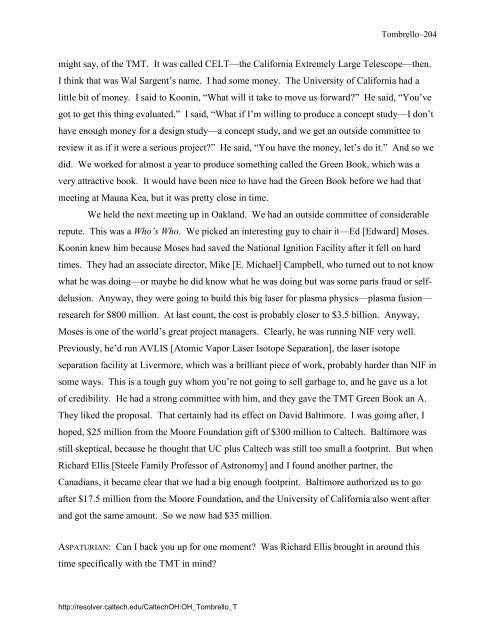Interview with Thomas A. Tombrello - Caltech Oral Histories
Interview with Thomas A. Tombrello - Caltech Oral Histories
Interview with Thomas A. Tombrello - Caltech Oral Histories
Create successful ePaper yourself
Turn your PDF publications into a flip-book with our unique Google optimized e-Paper software.
<strong>Tombrello</strong>–204<br />
might say, of the TMT. It was called CELT—the California Extremely Large Telescope—then.<br />
I think that was Wal Sargent’s name. I had some money. The University of California had a<br />
little bit of money. I said to Koonin, “What will it take to move us forward?” He said, “You’ve<br />
got to get this thing evaluated.” I said, “What if I’m willing to produce a concept study—I don’t<br />
have enough money for a design study—a concept study, and we get an outside committee to<br />
review it as if it were a serious project?” He said, “You have the money, let’s do it.” And so we<br />
did. We worked for almost a year to produce something called the Green Book, which was a<br />
very attractive book. It would have been nice to have had the Green Book before we had that<br />
meeting at Mauna Kea, but it was pretty close in time.<br />
We held the next meeting up in Oakland. We had an outside committee of considerable<br />
repute. This was a Who’s Who. We picked an interesting guy to chair it—Ed [Edward] Moses.<br />
Koonin knew him because Moses had saved the National Ignition Facility after it fell on hard<br />
times. They had an associate director, Mike [E. Michael] Campbell, who turned out to not know<br />
what he was doing—or maybe he did know what he was doing but was some parts fraud or selfdelusion.<br />
Anyway, they were going to build this big laser for plasma physics—plasma fusion—<br />
research for $800 million. At last count, the cost is probably closer to $3.5 billion. Anyway,<br />
Moses is one of the world’s great project managers. Clearly, he was running NIF very well.<br />
Previously, he’d run AVLIS [Atomic Vapor Laser Isotope Separation], the laser isotope<br />
separation facility at Livermore, which was a brilliant piece of work, probably harder than NIF in<br />
some ways. This is a tough guy whom you’re not going to sell garbage to, and he gave us a lot<br />
of credibility. He had a strong committee <strong>with</strong> him, and they gave the TMT Green Book an A.<br />
They liked the proposal. That certainly had its effect on David Baltimore. I was going after, I<br />
hoped, $25 million from the Moore Foundation gift of $300 million to <strong>Caltech</strong>. Baltimore was<br />
still skeptical, because he thought that UC plus <strong>Caltech</strong> was still too small a footprint. But when<br />
Richard Ellis [Steele Family Professor of Astronomy] and I found another partner, the<br />
Canadians, it became clear that we had a big enough footprint. Baltimore authorized us to go<br />
after $17.5 million from the Moore Foundation, and the University of California also went after<br />
and got the same amount. So we now had $35 million.<br />
ASPATURIAN: Can I back you up for one moment? Was Richard Ellis brought in around this<br />
time specifically <strong>with</strong> the TMT in mind?<br />
http://resolver.caltech.edu/<strong>Caltech</strong>OH:OH_<strong>Tombrello</strong>_T

















